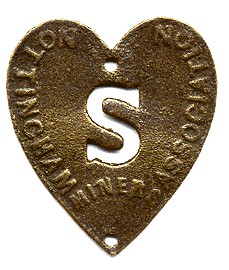
Soon after I took up metal detecting as a serious hobby I started to research each of my new finds and after a while I found that I could identify most of what I found quite easily. In spite of this newly found expertise the purpose of three of my finds, which took the form of thin and badly corroded brass discs, eluded me. Each of these discs was slightly larger than a two pence coin, but thinner, with two small holes on opposite edges of the flan. On each of the discs one side was blank while the other side had in the centre either a cut out number or letter. Around the edge of each of the obverse sides the words "Notts. Miners Association" could just be made out.

An ornate N.M.A. badge (Type 51) in the shape of a heart with a cut out "S" in its centre. As with the vast majority of N.M.A. badges that still exist this example is a metal detector find.
I decided to keep my eyes open for more of these brass discs, hopefully in better condition than the three I already had. After a while I found myself spending most of my detecting time on farmland instead of public parks. Naturally the percentage of modern finds went down but that was more than compensated for by the wide variety of artefacts I recovered. I noticed in particular that I was finding a few more of the Notts. Miners' Association discs with different numbers and letters on them, usually from fields near present or former coal mining communities, especially Hucknall, Linby and Kirkby. At this time I live in a small mining village in what was the North Nottinghamshire Coalfield and many of my friends were miners. Unfortunately my enquiries with them into the origin of the discs were not very successful but one of the "old timers" suggested that they might have been pre-war union badges or tokens. This rekindled my interest in the brass discs so I read all the books about the history of the early Nottinghamshire miners I could get hold of. I found many references to the Nottinghamshire Miners' Association, including details of its struggle for survival and recognition from its foundation in late 1885 through to its merger with the Spencer Union in 1938. Very few authors mentioned the tokens or discs used by its members and those that did made only passing reference to them. I must admit that not being interested in the union movement made my researches heavy going. However, a few references I found did confirm that the discs were in fact early union badges. The miners would have been issued these by the N.M.A., for a small fee, and would have worn them as proof of their membership to the union. The badges would have been sown onto their owners' caps or jacket lapels via the two small fastening holes provided.
One of my original research objectives, apart from discovering the history of the badges, was to identify the sites of the open-air meetings held by the Nottinghamshire Miners' Association. Unfortunately the historians I read did not attach the same importance to these sites as I did. My investigations only led me to discover the locations of two of the Association's meeting places that had not been built over since those days. On one of these locations I already had permission to detect and had recovered a few badges. The other was owned by a local Baronet who had previously refused me permission to detect on his land. This was particularly disappointing because apart from the regular meetings of union members there had been a report of a small riot on the site at a strike meeting during the early days of the Association. No doubt many miners could have lost their badges on this occasion and hence the site could have yielded many finds.
Over the years my collection of different Nottinghamshire Miners' Association badges, recovered in a suitable condition to display, has grown to 61 different types including one issued in the name of the Derbyshire and Nottinghamshire Miners' Association. This number is out of a total of over 200 that I have found, the majority of which have been in a poor condition due to the action of fertiliser and chemicals in the ground. I am adding new badges to my reference collection as I find them and replacing those in poor condition whenever possible.
It is interesting to note how many different types of N.M.A. membership badge are so far known and how extremely prolific their survivals have been into current times compared with similar badges from other major British coalfields. I am not sure of the reasons behind these two observations but it is interesting to note that a very large number of the surviving badges are metal detector finds.
Below is listed a description of the 61 different Nottinghamshire Miners' badges in my collection in addition to an additional 12 types which I know to exist. It would appear, however, that there are many more still to be discovered.
A Provisional Listing of Early Miners' Union Membership Badges from Nottinghamshire
Unless otherwise stated all of the badges described below are of brass and are round with an embossed uniface design and plain smooth edge. All have two small fastening holes located on their edges at the "3" and "9" o'clock positions as is normal for such badges;
Clover shape (31.85mm across), legend in four lines; NOTTS. / MINERS / ASSOCIATION / 1896
Clover shape (32mm ACROSS), legend in four lines; NOTTS. / MINERS / ASSOCIATION / 1897
Round
(29.02mm dia.), legend
around central date; NOTTS. MINERS ASSOCIATION / 1903
Round (29.89mm dia.), legend around central date; NOTTS. MINERS ASSOCIATION / 1904
Oval (31.26x22.56mm), legend around central date; NOTTS MINERS ASSOCIATION / 1905
Round (32.56mm dia.), legend around central cut out date; NOTTS MINERS ASSOCIATION / 1909
Round (31.79mm dia.), legend around clasped hands and date; NOTTS MINERS ASSOCIATION; below hands 1925
Round (28.86mm dia.), legend around central depiction of a miner kneeling with both hands plus one foot on a pit prop (?); NOTTS. MINERS ASSOCIATION. Fastening holes located at the "6" and "12" o'clock positions.
Round (28.57mm dia.), legend around central depiction of a heart in the palm of a hand; NOTTS MINERS ASSOCIATION. Fastening holes located at the "6" and "12" o'clock positions.
Serrated (16 point) circle (31.56mm dia.), legend around central depiction of a heart in the palm of a hand; NOTTS MINERS ASSOCIATION. Fastening holes located at the "6" and "12" o'clock positions.
Oval (36.38x23.93mm), legend around edge; NOTTS MINERS ASSOCIATION; in centre MINIMUM WAGE
Round (32.70mm dia.), legend in three lines across centre; NOTTS / MINERS / ASSOCIATION
Square (26.38mm), legend within inner beaded circular border; NOTTS. MINERS ASSOCIATION
Round (28.42mm dia.), legend around edge NOTTS. MINERS ASSOCIATION; in embossed script in the centre the name ‘W. Bailey’. Milled edge
Square
(25.86mm), legend
NOTTS MINERS ASSOCIATION
Round
(32.36mm dia.), legend
NOTTS MINERS ASSOCIATION around a cut out
four point star
Upright
Oval (34.24x23.24mm), legend
in three lines NOTTS / MINERS / ASSOCIATION
Round
(28.80mm dia.); Obv.
outer
legend
NOTTS. MINERS ASSOCIATION
Round
(28.65mm dia.); Obv. outer
legend
NOTTS. MINERS * ASSOCIATION
Round
(32.55mm dia.), legend
NOTTS MINERS ASSOCIATION
Round
(29.46mm dia.),
legend
NOTTS MINERS ASSOCIATION
Round
(32.27mm dia.)
Round
(29.98mm dia.),
Round
(29.74mm dia.), legend
NOTTS MINERS ASSOCIATION
Round
(32.17mm dia.), legend
NOTTS MINERS ASSOCIATION
Round
(32.56mm. dia.), legend
NOTTS MINERS ASSOCIATION
Round
(31.79mm dia.),
Round
(32.93mm dia.),
Round
(32.90mm dia.),
legend
NOTTS MINERS ASSOCIATION
Round
(31.87mm dia.),
Round
(32.53mm dia.),
Round
(32.41mm dia.), legend
NOTTS MINERS ASSOCIATION
Round
(32.54mm dia.), legend
NOTTS MINERS ASSOCIATION
Round
(32.25mm dia.),
legend
NOTTS MINERS ASSOCIATION
Round
(32.39mm dia.), legend
NOTTS MINERS ASSOCIATION
Oval
(28.96x21.06mm),
legend
NOTTS. MINERS ASSOCIATION
Round
(27.88mm dia.),
Round
(27.76mm dia.),
Round
(28.02mm dia.),
Round
(28.26mm dia.),
Round
(28.76mmdia.), legend
NOTTS. MINERS ASSOCIATION
Round
(28.57mm dia.),
legend
NOTTS. MINERS ASSOCIATION
Round
(29.02mm dia.),
legend
NOTTS. MINERS ASSOCIATION
Round
(28.90mm dia.),
legend
NOTTS. MINERS ASSOCIATION
Round
(28.86mm dia.),
legend
NOTTS. MINERS ASSOCIATION
Oval
(31.10x22.60mm),
legend
NOTTS. MINERS ASSOCIATION
Round
(28.71mm dia.),
legend
NOTTS MINERS ASSOCIATION
Round
(29.22mm dia.),
legend
NOTTS. MINERS ASSOCIATION
Round
(32.10mm dia.),
Round
(29.26mm dia.),
legend
NOTTS. MINERS ASSOCIATION
Heart
Shaped (30.49x26.69mm), legend
NOTTINGHAM MINERS ASSOCIATION
Round
(29.40mm dia.),
legend
NOTTS. MINERS ASSOCIATION
Oval
(34.19x22.98mm), legend
NOTTS. MINERS ASSOCIATION
Round
(29.73mm dia.), legend
NOTTS. MINERS ASSOCIATION
Round
(29.76mm dia.)
legend
NOTTS MINERS ASSOCIATION
Round
(29.80mm dia.),
legend
NOTTS MINERS ASSOCIATION
Round
(32.04mm dia.), legend
NOTTS MINERS ASSOCIATION
Round
(31.94mm dia.),
Round
(29.56mm dia.),
legend
NOTTS MINERS ASSOCIATION
Round
(31.50mm dia.), legend around edge DERBYSHIRE & NOTTINGHAMSHIRE
Rectangular (33.58mmx24.14mm), Legend at top and bottom NOTTS MINERS / ASSOCIATION; embossed script in the centre the name W. Bailey and below the further legend SEC. & AGENT . Struck in copper.
Round
(32mm dia.),
legend
NOTTS MINERS ASSOCIATION
Round
(32mm dia.),
legend
NOTTS MINERS ASSOCIATION
Round
(32mm dia.),
legend
NOTTS MINERS ASSOCIATION
Round
(~32mm dia.),
legend
NOTTS MINERS ASSOCIATION
Round
(~32mm dia.),
legend
NOTTS MINERS ASSOCIATION
Round
(31mm dia.),
legend
NOTTS MINERS ASSOCIATION
Round
(31mm dia.),
legend
NOTTS MINERS ASSOCIATION
Round
(~32mm dia.),
legend
NOTTS MINERS ASSOCIATION
Square
(25.4mm), legend
NOTTS MINERS ASSOCIATION
Round
(28.0mm dia.); Obv.
outer
legend
NOTTS MINERS * ASSOCIATION
Round
(28.0mm dia.); Obv.
legend
around circular inner border NOTTS. MINERS * ASSOCIATION
Round
(28.0mm dia.); Obv.
outer
legend
NOTTS. MINERS * ASSOCIATION
A further N.M.A. badge is listed in the third edition of John Hammond's book of Trade Union Badges. As yet I have been unable to confirm the existence of this badge in any private or public collections. This additional badge is very scantily described as being round, brass and depicting a tubular cain and lath bundle.
Acknowledgements:
I would like to thank Alan Cope, Mark Smith, and M.I. Cobwright for supplying me with details and photographs of N.M.A. badge types 70 to 73. I also thank Mark Smith for informing me of the as yet unverified N.M.A. badge listed in John Hammond's privately produced book "Trade Union Badges - A Guide For Collectors" (Third Edition, 1996).
The
above
article has been re-titled and adapted from the author's private publication entitled "Nottinghamshire
Miners' Association Membership Badges Recovered With A Metal Detector"
and has here been reproduced for this web site with his kind permission. © John
Gough 2003.
An Introduction to Nottinghamshire Miners' Association Badges:
Part II - A Brief History of the N.M.A. plus some Observations on its Membership Badges
The first attempts to establish a miner's union within the Nottinghamshire Coalfield occurred in 1844 but it failed to gain recognition from the coal owners and collapsed only a year later. Despite this the embers of unionism lingered on in certain areas of the coalfield such as at Cinderhill Colliery. By1863 support for a local miner's union had sufficiently increased again to warrant the formation of the Derbyshire and Nottinghamshire Miner's Association. This union comprised of various miner's lodges located throughout the two adjacent coalfields. Despite various strikes and lockouts this organisation appears to have still been in existence when in 1880 the Derbyshire Miner's Association was formed and then in 1881 the Nottingham Miners' Federation came into being.
In December 1885 the Nottinghamshire Miners' Federation was re-organised and re-established itself under the new name of the Nottinghamshire Miners' Association (N.M.A.). Under the rules of this re-formed union the powers of the individual colliery lodges or branches were much reduced with the majority of control and decision making being vested in the association's central executive committee.
In 1886 the membership of the re-formed N.M.A. had diminished to a mere 500 men with only eleven branches remaining through out the entire coalfield. Consequently funds became dangerously low and Mr. Hopkin, the Association's first agent, could not be paid. In the Autumn of the same year he resigned. William Bailey then became the full time agent and secretary of the N.M.A. Under his very able and respected leadership the union's membership grew (as can be seen from Figure 1 below) to nearly 19,030 by 1895. This figure represents nearly 84% of the total workforce (of 22,758 workers of which 4,707 were surface men) recorded by H.M. Inspector of Mines for the Nottinghamshire coalfield in that same year.
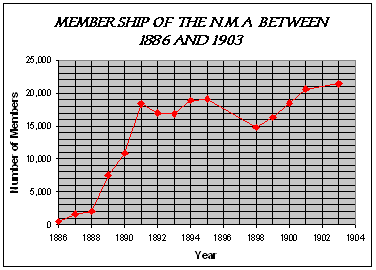
Figure 1: Membership numbers of the N.M.A. between 1886 and 1903.
William Bailey was a respected leader plus a tremendous driving force in the evolution of mining trade unionism within the Nottinghamshire Coalfield. Born the son of a British soldier in the garrisoned island of St. Helena, William came to England with his farther at the age of nine. He entered the Nottinghamshire mining industry in his early teens and ultimately became the check weighman at Norwood Colliery. After loosing his position at Norwood after an industrial dispute in 1884 he soon afterwards moved on to become the N.M.A.'s second secretary and agent. He maintained these roles together with those of both a local councillor and Methodist preacher until is untimely death at the age of 45 on 26th July 1896.
Figure 2: Councillor William Bailey - Secretary & Agent of the N.M.A. from 1886 to 1896.
It is possible that at least one of the two known types of N.M.A. badge which bear an embossed representation of William Bailey's signature were issued in the year of his death as a form of respectful commemorative. A similar commemorative union membership badge was issued in 1912 by the North Staffordshire Miners' Federation to commemorate the death of their then secretary and agent Enoch Edwards.
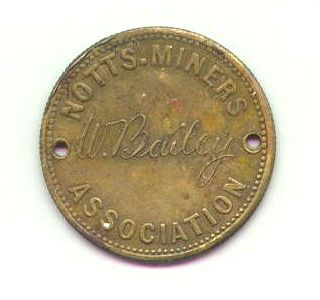
Figure 3: N.M.A. Badges (Types 61 & 14) bearing a copy of the signature of William Bailey.
All the early union membership badges known from the Nottinghamshire Coalfield, with the exception of one, have the words "Notts. Miners Association" (or similar) on them. Hence, it is reasonable to assume that they must all date to a period post 1885. The one exception to this is badge Type 60 which was issued in the name of the DERBYSHIRE & NOTTINGHAMSHIRE MINERS' ASSOCIATION and hence must date to the earlier period of 1863 to 1881. Based on information gathered from a study of other British miners' association badges the location of the paired fastening holes on badge Type 60 also points stylistically to an earlier date of issue. It is interesting to note that as yet no membership badges have come to light that were issued in the interim years 1881 to 1885 when the Nottinghamshire Miners Federation was in existence.
In 1891 the N.M.A. issued badges to paid-up members at Annesley, Bestwood, Hucknall, Linby and Newstead collieries in an attempt to persuade non-union members to join. From the beginning of 1892 a member of the union was required to wear a badge that denoted that he was a paid up member. At some pits members of the union refused to ride in the cages with men who were not wearing the current design of membership badge. This attitude to none paid up members was again promoted by the N.M.A. in its "back to the union" campaign which started in 1922.
Most of the known N.M.A. badges are generic types issued solely in the name of the Association itself. However, several colliery branch or lodge badges were also issued under the umbrella membership of the N.M.A. Known types of these included examples from Wollaton Branch, Cinderhill Colliery, Hucknall Top Pit Branch and Linby.
The earliest dated N.M.A. badges are two separate types, one circular the other square, both of which carry the date April 1895. Several later dated badge issues are also known. These include ones for 1896, 1897, 1903,1904, two different examples for 1905 (one circular the other oval), 1909 plus a much later example bearing the date 1925. It is also tempting to attribute certain of the other none dated N.M.A. badges to specific years of issue. For example badge Type 11 which carries the motto MINIMUM WAGE may well have been issued for use in 1912. This being the year of the well known national miner's strike which was aimed at establishing a minimum legal miner's wage. Also for reasons discussed earlier it is very possible that one or both of badges Types 14 and 61 date to the years 1896 or 1897.
The vast majority of N.M.A. badges are based on designs featuring cut out numbers or letters. With the current exception of any badges bearing the numbers "8" to "10" a full range of badge issues numbered from "1" to "11" are known. All of these numbered badges appear in two or three different die varieties. Badges bearing either cut out and occasionally embossed letters are known covering the full breath of the alphabet "A" to "Z". Presumably each of the various badges in these numbered or lettered series were issued sequentially. It is interesting to note that similar cut out designs are known for membership badges issued by other contemporary British miners' associations and federations. These include those operating in Shropshire, Cannock Chase, North Derbyshire and North Staffordshire to name but four.
Several of the N.M.A. badge designs (Types 7,9,10,15 and 70) feature typical symbols of fraternal solidarity and unity. Such symbols include shaking or clasped hands plus the lesser known image of an open palm holding a heart. Without a doubt the most puzzling of all the N.M.A. badge designs is that of Type 8. This is usually referred to as the "kneeling miner" type. It depicts the figure of a man kneeling on his knees and holding what could possibly be a pit prop. The significance behind this enigmatic badge design now appears lost.
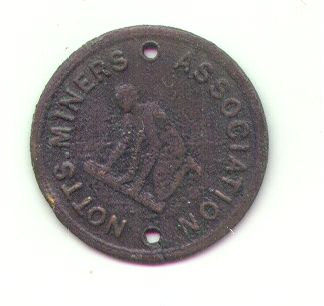
Figure 4: N.M.A. Badge Type 8 portraying the enigmatic "kneeling miner" design.
One N.M.A. badge described in Hammonds's guide to "Trade Union Badges" is described (all be it briefly) as depicting a tubular cain and lath bundle. The unusual item described sounds very similar to an ancient Roman fasces. The fasces were a symbolic bundle of rods which were bound together with an axe head in beaded at its head. This symbolic devise was normally carried by special bearers (Lictors) in front of public magistrates and officials during official ceremonies as a sign of their authority. The badge description makes no mention of any axe head. This could be just an oversight or it may have some symbolic significance. In ancient Rome if the axe was left out of the construction of the fasces it could mean that the magistrates wanted to request something from the people or had something to apologize for. Again the significance and symbolism behind this badge are now lost.
It is generally believed that new designs for N.M.A. membership badges were introduced to mark successive financial membership periods. This would certainly explain the reason for why so many different numeric and alphabetic designs are known. It has been suggested that for an unknown number of years new membership badges were variously issued either annually, bi-annually or possibly even on a quarterly basic, as is known from elsewhere in the United Kingdom. To support the bi-annual issuing theory the design of one badge (Type 71), issued by the Cinderhill Colliery Branch of the N.M.A., is marked with the membership period "APRIL TO OCTOBER" (the year of issue is not stated). In addition two further badge designs (Types 69 and 70) are also known bearing the legend APRIL 1895, which presumably refers to the precise date of their issue.
To further collaborate the concept of bi-annual issuing of membership badges by the N.M.A. we can also draw on the following observations. In December 1899 it is known that membership of the association stood at 16,275. This represented an increase of 1,500 new members during the financial year. The expenditure for badges in that same year is known to have amounted to £118 (or alternatively 118x240=28,320 old pennies). By assuming the average membership of the association over that year to have been approximately 15,500 a simple calculation (i.e. 15,500 into 28,320) would indicate that the annual expenditure on badges was approximately 1.82d. per man. Based on this information and on the recorded fact that in the same year the Derbyshire Miners' Association issued 6,000 of its membership with similar badges at a cost of 1d each, it seems likely that during 1899, at least, the N.M.A. issued new membership badges on a half yearly basis.
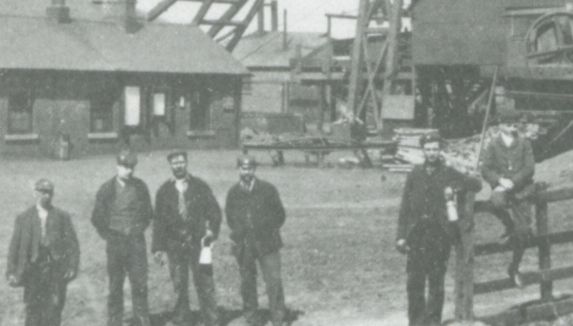
Figure 5: Miners at Hucknall Colliery c.1900. Note at least four of these men have N.M.A. badges sown onto their caps.
It is not known when the N.M.A. ceased the tradition of issuing membership badges. The latest dated badge bears a date of 1925. As yet no pin, button hole or enameled type membership badges, such as those normally associated with the second quarter (or later) of the twentieth century, are known to have been issued in the name of the union.
After 1926 the N.M.A. started to rapidly loose members to the breakaway Nottinghamshire & District Miners' Industrial Union (otherwise known as the Spencer Union) which emerged after the general strike of that same year. By the time of the final re-conciliation and merger of these two rival unions in 1937, under the title of the Nottinghamshire Miners' Federated Union (N.M.F.U.), the N.M.A. was a mere shadow of its former early twentieth century self. This new united miner's union was to have only a sort existence being ultimately replaced in 1945 by the Nottinghamshire Branch of the National Union of Mine Workers (N.U.M.).
There is still much research needed to define the detailed method of use plus general history behind the miners' association badges of Nottinghamshire. Unfortunately with many of the Association's records now believed lost or destroyed (this probably occurred during the period leading up to the establishment of the Nottinghamshire Branch of the N.U.M.) such additional research is going to be an extremely challenging task.
References & Further Reading:
The Miners Of Nottinghamshire. Volume I - 1881 to 1914. Alan R. Griffin. Nottinghamshire Press. 1955.
The Miners Of Nottinghamshire. Volume II - 1914 to 1944. Alan R. Griffin. George Allen & Unwin Ltd. 1962.
Trade Union Badges - A Guide for Collectors. Third Edition. John Hammond. Private Publication. 1996.
The Nottinghamshire Coalfield 1881 to 1981 - A Century of Progress. Alan R. Griffin. Moorland Publishing Co. Ltd. 1981.
A Pictorial History of the N.U.M. Derbyshire Area - 100 Years of Progress 1880 - 1980.
Trade Union Badges - A Guide For Collectors (Third Edition). John Hammond. Private Publication. 1996.
©
Mark Smith & John Gough 2003.
If If anyone would like to comment or has any further information concerning any of the N.M.A. badges discussed above then please contact us via the e-mail reply link below.